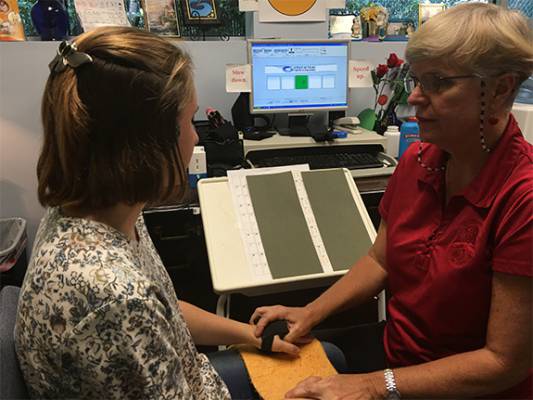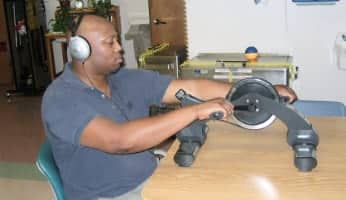Megan’s Life Transformed After Training with Interactive Metronome

Home - Testimonials - Pediatric Testimonials - Megan’s Life Transformed After Training with Interactive Metronome

Megan’s Life Transformed After Training with Interactive Metronome
Megan’s father knew he suffered from the same problem as his child. Now he saw his own daughter, who was 17 years old, struggle with understanding conversational speech, remembering instructions, garbling complex words, forgetting words that she should know, suffering with dyscalculia, and withdrawing from friends all because of an Auditory Processing Disorder (APD).
A Father’s Research
He interviewed every “expert” he could find in the city of Jacksonville, Florida, asking them questions:
- What causes an Auditory Processing Disorder?
- How do you resolve the problem?
- What is your success rate?
- Do you take insurance?
He visited Merritt Speech & Learning, but he did not like the fact that they do not take insurance, nor did he like the fact that Dana Merritt wanted to assess Megan’s Visual Processing & Auditory Processing skills at the same time.
Initial Diagnosis
Six months later, Megan was diagnosed with Specific Learning Disability with impairment math, Unspecified Anxiety Disorder, Unspecified Depressive Disorder, Normal Hearing and Abnormal Auditory Processing by a cascade of professionals. Their reports are in his hands, yet she is not any better. Megan’s father called Merritt Speech & Learning again, asking, “Will you help my daughter?”
Megan was then diagnosed by Dana Merritt with a Visual Processing Disorder, Impairment of Auditory Discrimination, Hyperacusia, Specific Reading, Disorder, and Mathematics Disorder.
Surprisingly, she was almost 5 years delayed in her expressive vocabulary skills based on the Expressive One Word Picture Vocabulary Test (EOWPVT).
Initial Progress Leads to Optimism
She completed 9 sessions of Visual Processing Therapy during a three month time period where Merritt’s unique A Time for Phonics Program was utilized. Her father described Megan’s progress: “Her attitude is very positive and optimistic. Her speech is more clear and distinct. Her vision seems better.”
Megan described her progress: “I think some aspects were helpful, but I still can’t pronounce some words.” It was then time to administer the Auditory Processing, Speech & Language Evaluation.
There were two shocking findings during the evaluation.
Megan had made 4 years-10 months of progress in her expressive vocabulary skills on the EOWPVT, and she was now above her chronological age.
Then on The Goldman-Fristoe-Woodcock (GFW) Test of Auditory Discrimination, Megan was at the 42nd percentile for Quiet, but she was below the 1st percentile in Noise. Shockingly, during the background noise (BGN) of the GFW, Megan became notably overwhelmed, anxious, and distressed because she didn’t get it. She wasn’t understanding what they were saying.
Merritt tried calming her down and get her to just listen to what the instructor was saying as well as get her to ignore the background noise. She tried, but she went from barely understanding the Quiet instructions i.e., “Point to the cone” when the four pictorial choices were core, coal, comb and cone- to utter failure as soon as the background noise of a school cafeteria were added to the task.
She pleaded with Dana, “Can you stop this test? I can’t do this!” Because Dana Merritt did not want to add to Megan’s stress and anxiety she stopped the test.
Megan’s Severe Auditory Processing Disorder (below the 1st percentile in the presence of BGS) was hindering her comprehension skills in everyday life, this test proved it.
Starting Early Intervention with Interactive Metronome
The parents agreed and Megan was enrolled in the Early Intervention.
This program was designed by Dana Merritt, MS, CCC-SLP, and utilizes Interactive Metronome® (IM). IM is a brain-based rehabilitation assessment and training program developed to directly improve the processing abilities that affect attention, processing skills, and sequencing.
This, in turn, strengthens many fundamental cognitive capacities such as planning, organizing and language. Research shows that combining movement and cognitive tasks leads to better overall outcomes and improvements in language and cognition, stronger motor control and coordination, and enhanced balance and gait.
IM is the only training program that improves timing in the brain in an organized, systematic, flexible and engaging format. In addition, IM provides excellent auditory stimulation to the auditory cortex while the clinician moves the student through five different modified exercises.
Four of the five movements were done for Megan, and was averaged 16.92 milliseconds of time to maximize the auditory feedback of “Sweet Sounds” for her on an average day of therapy.
Megan was simultaneously presented with excellent verbal and visual stimulation through what is referred to as the “ear gates”, the “eye gates” and the “motor gates” to develop multiple association fibers between the auditory, visual and motor areas.
For her Right Hand she was verbally presented with Weber’s Minimal Pair Cards first, then she was allowed to see the card and was to state the word she had heard. Megan was very honest to say for example, “I thought you said ‘yard’ but it is ‘guard’.”
We kept track of her spontaneous self-corrections, and then we would do her Left Hand with the next set
of minimal pair words. We would do Both Hand exercise where Megan was reading progressively longer sentences were loaded with the phonemes that were the most difficult for her to discriminate.
We then moved her through a Patty Cake type exercise where Megan would work on quick addition skills by going up the 100 table by 2s, 3s, 4s, etc. For the fifth exercise, Megan would stand up and initially, Dana would move her feet through the Both Toes exercise.
However, Megan’s balance was such an issue, that she had to be caught before she fell over. She progressed to doing this so well that they worked across from each other while Dana held her hands. She advanced to doing this exercise while watching the computer and keeping her scores within the 20 millisecond range. These procedures with Interactive Metronome’s patented guidance system provided significant gains.
Outcomes with IM
Megan completed fifteen sessions of IM training, three times a week for five weeks. Within those 15 sessions, Megan loved seeing her own progress in the reductions of self-corrections that she was making in the work.
She loved seeing the math facts begin to flow from her own memory and loved seeing progress on her motor coordination skills.
The day came to re-administer the GFW, the goal was to see if there was any difference in her skills in auditorially discriminating single words in Quiet and in Noise. She was now at the 100th percentile in Quiet and at the 78th percentile in Noise, which were all done without any stress or anxiety by Megan.
She has progressed on into Fast ForWord and is making outstanding progress. She has become a confident, young student who aspires to go to college.
She said, “Miss Dana, I can even walk by people who are talking to each other and I can understand every word they say. Before IM training, All those words melted together and now I can say long complex words easily.”
Megan also said that before IM training, friends would tell stories or jokes and couldn’t understand what was so funny. Now, she says that she can laugh along with the others, because, “I really get it.”
In just a few weeks, Interactive Metronome® transformed her life.
Dana Merritt, MS, CCC-SLP
Merritt Speech & Learning
Jacksonville, FL




